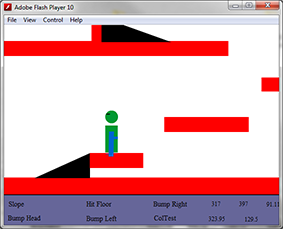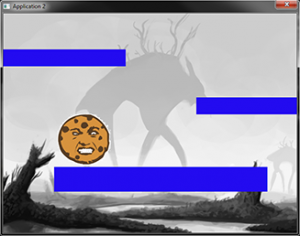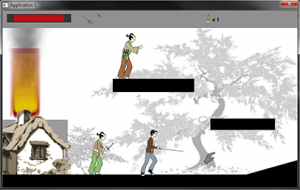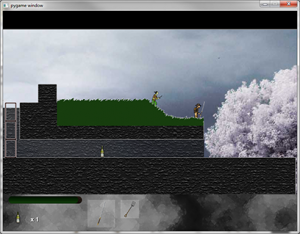After watching someone else play through the main game, I felt compelled to make some more changes:
1) The dialogue that shows up after you (unsuccessfully) hit the Ronin-phase 1 with the katana 5 times wasn’t happening. I fixed that, and changed it so you only have to hit him 3 times, instead of the 5 from before
2) When I changed the way melee weapons worked, I made it so you can effectively make a “pitchfork umbrella,” thus avoiding any damage from the ronin. That’s weird, and it shouldn’t happen, so I fixed it. Meanwhile, “pitchfork umbrella” will be added to the list of amusingly-named bugs I’ve encountered, along with “rocket ladders.”
3) The mini-boss will show that he’s vulnerable during the jump by flashing the notice-me!-color as he flies from wall to wall (maybe the inside of his cloak/wrap thing). But the point that was brought up is that it’ll be the player’s first encounter with the color, and might not know to pay attention to it. So I added a switch to the first guard tower that heads over the bridge; you’ll have to hit the switch to open the door, and the switches will have that color also, helping to reinforce that the color means “hit me with a sword!”
4) Some people weren’t even noticing that the player blinks after he’s been damaged, signifying the short period of time he’s invulnerable after a hit. I tried to change it so he flashes white instead of just on-off, but the best I could get was a weird blending-mode thing with a copy of his sprite that stays in front of him. Because of this, I’m sort of expecting issues with it. When you play, look for animation issues with the player’s sprite!
5) During phase 2 of the ronin fight, if you stay away from the walls, you’ll never see him run into one and stun himself, which means you won’t be aware that there even is such a thing as him being stunned, which means you’ll probably die wondering “Why can’t I hit him with the katana?” I changed the battle so the Ronin just walls from wall to wall, hoping to catch you in his charge. This made it a little easier than I was hoping for, so to compensate, I added another fire-guard, but decreased both of their firing rates. Play through this part a couple times, if you will, and let me know if it’s too unbalanced.
6) I’d been waffling for a while about making the “climb up a ladder” button separate from the “jump” button. I was trying to avoid adding an extra key, but it was pointed out to me that the space bar, or shift, or some other second key just feels more natural. So now the “w” and “up” keys are only for ladders, the spacebar makes you jump.
7) I’ve seen a few people now try to click the menu options, and that’s not something that can be done (not yet, anyways. Maybe someday.) So I hid the mouse cursor any time the menu is up. However, I’ve noticed some weird issues where if the menu comes up because the window lost focus, the mouse cursor doesn’t come back when you resume, and you have to bring the menu back again to make it happen. Still looking in to it.
8) I also spent forever working on a new swirly “I died and now the screen is turning black” bit, instead of just the radial fade-to-black thing that happened before. It needs more frames; it looks a little stuttery, but I guess if I hadn’t said anything, you’d’ve just assumed that it was supposed to look like that and was kind of artsy. I dunno; like all the other graphics in the game, it won’t be sticking around. But this has helped me create a framework so that I can add any animation I want there, instead of relying on black blocks that converged on the player like before.
Also, you’ll see that I’ve updated the “waking” isometric download as well. The layout is complete, the isometric tile-filling function works, and I’m currently in the middle of adding the actual game functions. You can walk into your apartment, but it’s pretty bare right now. The walls turn translucent when you walk in front of them, but not the buildings, and I think I’m going to leave it that way.
Also, some of the buildings have some weird clipping issues where they sometimes show up in front of or behind the player when they’re not supposed to- that’s just laziness on my part. I need to split them up into separate images and control which ones appear on top when. That’s just not at the top of my priority list right now.
I need to make a map function, so you can press a key and see where everything is. I need to start adding little wandering NPCs and a way to talk to them. I need to make it so you can interact with objects, such as your phone, the library, etc.
Torque 2D just released the newest build of their engine, and I find myself unsure as to whether or not I want to convert.
Pros: It comes with built-in isometric support, as opposed to the bastardized thing I had to whip together. It merges animated and static sprites into one easier-to-use class. It also, likely, fixes some of the weird issues I’ve seen with tilemaps and particle effects.
Cons: It’s not backwards compatible with the level editor. In fact, there isn’t a level editor for it, so I’d have to make my own. Not to mention that the perks that come with a merged static/animated sprite means I’d have to go back and recode everything that deals with displaying and animation. Also, it’s still super-new, so there are likely to be little bugs and issues that haven’t been caught yet.
The longer I wait, the more work I’m going to have to go back and redo. But I don’t want to have to spend all my time porting everything over to the new version only to find that it’s really not that much different from what I already have. Not to mention that everything I’ve done with the isometric engine will have to go away, since it supports its own version of that. Really, the only reason this is an issue for me at all is because I’m afraid that the help forums I’ve been relying on will start to go away once everybody makes the change. If I have an issue, I won’t be able to ask about it in the forums, since the first question they’ll ask is “Are you using the newest build?”
I’m still going to think about it for a bit, but I’m honestly leaning more towards just sticking with what I have.
Before I wrap this up, I have a couple links to share. The first one is one of those “Top 6 blahblahblah” articles that Cracked makes- I’m sure you’re all familiar with them. This one is about how video game designers messed with people who downloaded illegal versions of the game. It’s pretty impressive, actually. Read the one about Earthbound!
6 Hilarious Ways Game Designers Are Screwing With Pirates
The second link is a presentation that someone gave during the Game Developer’s Conference in 2011 about depression and game programming. He talks about finding motivation and inspiration, and a lot of his talk focuses on methods to use when you’re just a one-man game studio, which is especially applicable to me.
How To Function As A Depressed, Solo Game Developer
As usual, download and play! I need feedback!




